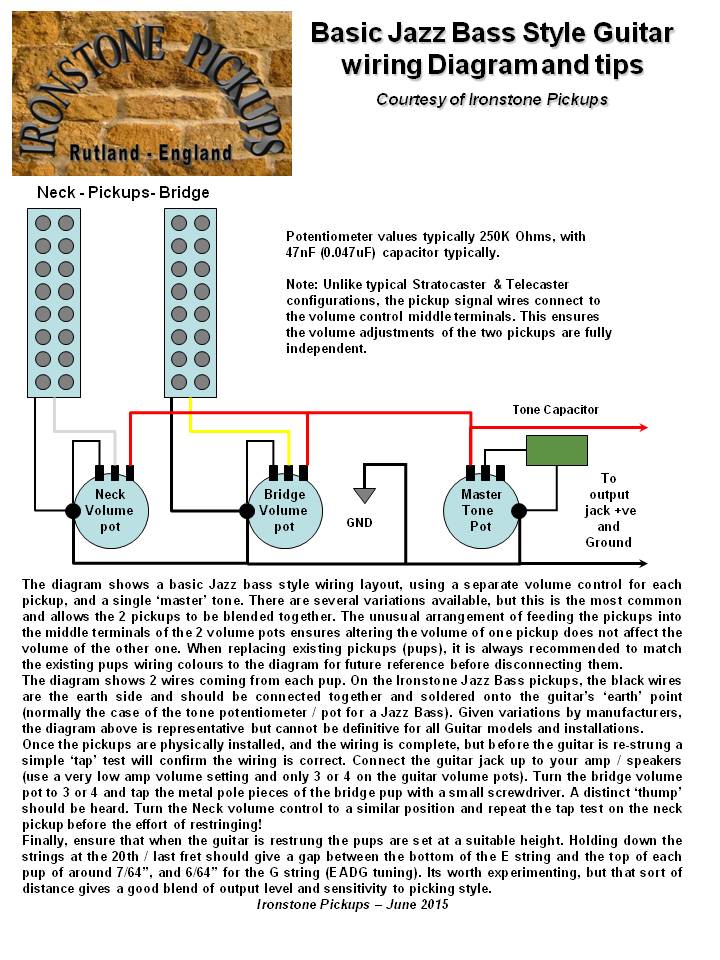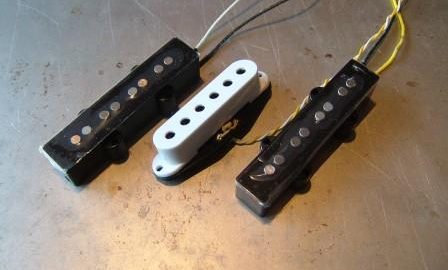Jazz Bass Dummy Coil Hum Cancelling :
Since Ironstone Pickups began selling Jazz Bass pickups in 2015, its become clear that, just like with their 6 string counter-parts, Jazz Bass players love the warmth and openness of tone that comes from the Jazz Bass single coil pickup design. But as any single coil, they are also susceptible to the unwanted electrical noise that the pickup interprets as signal. Sadly us humans detect that as noise not signal!
So assuming you want to keep your Jazz Bass tone and not opt for the Precision Bass humbucker pickup tone what can you do?
Types of electrical noise.
In an earlier Blog, I covered the types of electrical noise single coils are susceptible to. Check out the Blog;
Single Coil Pickup Dummy Coil
In that Blog I divide guitar noise into 2 basic elements, low frequency hum and higher frequency buzz (pretty commonly used terms). The most effective 'answer' to buzz is shielding.
See my Support page on the topic. Its aimed at 6 strings, but the principles are the same.
Electric guitar shielding
Hum is linked to magnetic fields created by mains power circuitry, so dominated by the frequency of the mains electrical system (50Hz here in the UK for example). Shielding will not remove hum, for that you need noise cancelling technology, and that's where dummy coils come in.
In the previous dummy coil Blog I covered the basics of pickup design and how a dummy coil can help. Also check out;
Electric Guitar Pickups Explained
So coming back to noise cancelling, this simply means adding an electrical signal containing unwanted noise to another signal containing the 'negative' or 'inverse' of that same noise. This cancelling (or 'bucking') of the hum is the principle of the humbucker design. So the humbucker (as found in a Precision Bass) is a very elegant hum cancelling solution, but the tonal characteristic is of course very different to that of a single coil.
Enter the Jazz Bass dummy coil.
So if you want your Jazz Bass pickups to keeps their tonal characteristic, where next? Well that is where the dummy coil approach comes in. Basically, a dummy coil can simply be a single coil without a magnetic component. The key requirement is that the dummy coil has its windings and / or its physical up / down orientation arranged to be in opposition to the live coil(s).
A dummy coil of around 80% of the live coils resistance value gives an excellent noise cancellation whilst leaving some 'life' in the signal which is so critical to single coil tone.
Now the tricky bit to installing a Jazz Bass dummy coil is that unlike (say) a Stratocaster, standardly configured jazz Bass guitars use a volume blend system not a distinct switch. This is further complicated by the fact the 2 Jazz Bass pickups will typically be RWRP (Reverse Wound Reverse Polarity) to each other. Since dummy coils have to be wound / connected in the reverse sense to the 'active' coil, the implication is that 2 dummy coils are needed. A standard Jazz Bass wiring schematic is shown below.

So my design goals evolved as the following;
1) Optimise the design to use just one dummy coil
2) Make the design easily compatible with standard 2 volume control, RWRP pickup Jazz Bass wiring
3) allow the players favourite 'both pickups at full volume' position to remain
4) provide hum cancelling for both bridge and neck pickups across their full volume control range.
It took a bit of experimentation, but it is possible to achieve all of the above with a simple dummy coil installation.The dummy coil is based on a Stratocaster pickup and with the simple use of some double sided tape can be mounted on the base of the standard Jazz Bass control plate potentiometers.
How does the Jazz Bass Dummy Coil sound?
As with any dummy coil installation, the Jazz Bass dummy coil set-up gives a reduction in overall output volume (approx. 10-15%). This is not surprising as the dummy coil is effectively subtracting from the live coils signal. More importantly, a huge proportion of the background hum will have gone, for both the bridge or neck selected at any volume individually.
The usual comment about dummy coils used on 6 string guitars is that the resulting tone has a drop in treble. It's a subjective view of course, and the associated drop in volume can add to that impression.
Clear with the different frequency and harmonic register of a Bass guitar, any impact on treble is significantly less audiable.
Once the volume is equalised out, you realise that there is really little tonal difference with the dummy engaged, except of course the welcome reduction in background hum. Check out the following sound clip to see.
This sound clips give a sense of the hum reduction based on a test guitar where the dummy coil is able to be switched in and out. The recordings were made with the test guitar laying flat, giving the highest level of background mains hum (try this yourself!).
It starts with the dummy coil off and a note played. After the note has faded, at 14 secs the coil is switched on giving the significant reduction in background hum. At approximately 25 seconds, the coil is switched off giving the jump in background hum.
So the above prototype seems to fulfil all of the design goals set. Hopefully, I will have it production ready a little later this year, and on sale through the Ironstone Pickups website.
Check out some more chat on the subject at;
basschat.co.uk/topic/194001-hum-cancellation-coils/
www.bestbassgear.com/ebass/gear/electronics/pickup/what-counts-as-a-humbucking-pickup.html



